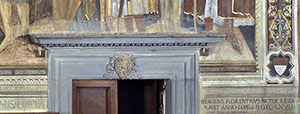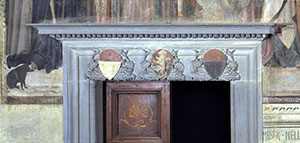
Lippo Memmi’s Majesty: restoration by Benozzo above the right-hand door, San Gimignano Town Hall.

Lippo Memmi’s Majesty: restoration by Benozzo above the left-hand door, San Gimignano Town Hall.

Lippo Memmi’s Majesty, detail of the sky, San Gimignano Town Hall.
The restoration of older works was already customary during Medieval times. The revitalization of paintings, especially the most venerated ones, was often quite frequent and could involve updates, adaptations and re-painting. In general, it was difficult for the painter who was ‘fixing up' a work to refrain from repainting it to enliven the colors when cleaning alone did not suffice, or to update the painting to reflect current iconography and fashions.
In addition to standard interventions necessitated by normal usage and aging, the reframing of cuspidate polyptychs was a special intervention that was widespread in Florence in the mid-15th century. New standards of decorum called for altars and chapels to be adorned with a square-shaped altar piece, and artists from the more important studios of the times sought to prove themselves by filling the empty spaces of large antique altar pieces that were still in favor, often adding renaissance style pilasters inspired by new trends in architecture.
The Alessandri family engaged Gozzoli to "freshen up" the thirteenth century polyptych of Lippo of Benvieni that had been executed for the family altar in San Pier Maggiore. What has survived from this work by Benozzo are the four dais panels (the largest of which depicts the Stories of the Saints), which are preserved in the Metropolitan Museum of New York.
The problem of fresco maintenance had already been encountered by painters during the fourteenth century, an epoch in which compensating for lost parts or renewing at-risk portions of plaster required interventions that were very similar to outright restoration because of the need to match the original surfaces. Efforts to match new sections with old ones involved the use of expedient and effective techniques, for sure, but they also involved attempts to imitate the formal sections of the model, even when the overall style was not fully comprehensible. In 1467, this is how Benozzo Gozzoli filled in the gaps and completed the resurfacing of Lippo Memmi's Majesty, which had been executed in 1317 in the Council Chamber of San Gimignano Town Hall, where the frescos had been compromised by two doors that opened right onto the frescoed walls themselves. The painter imitated the pointed feet of Saint Luigi in the thirteenth century painting and touched up the ancient scrapes with great care and without altering the stylistic unity. In this intervention, Gozzoli adhered to a strict sense of homogeneity, which is one of the requirements that gives restoration a different physiognomy than the normal painting activities.
This was not the only time this painter found himself intervening on one of the most ancient images. Indeed, approximately ten years earlier during his stay in Montefalco, Benozzo was engaged to "freshen up" an antique image of Saint Clare of Montefalco, which had been painted in the Augustinian convent dedicated to her in that city.
Serena Nocentini